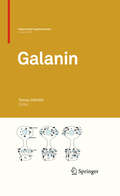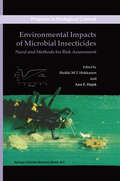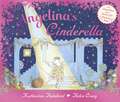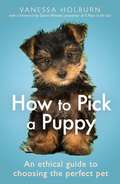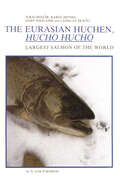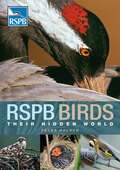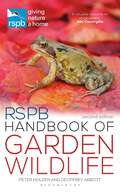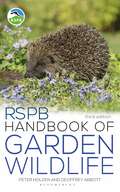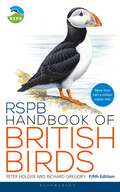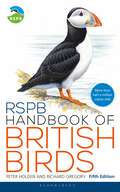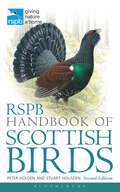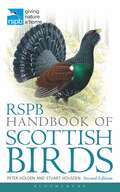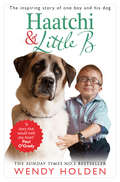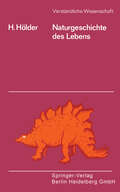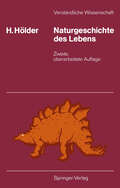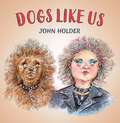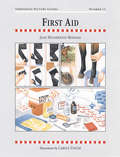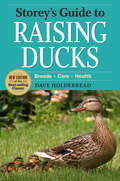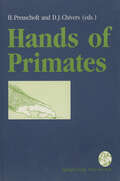- Table View
- List View
Galanin (Experientia Supplementum #102)
by Tomas HökfeltGalanin is a neuropeptide found both in the central and peripheral nervous system. The 29-amino acid peptide (named after its N-terminal glycine and C-terminal alanine) was identified in 1983 by its C-terminal amidation. This 'reverse' approach, that is to discover a substance through a distinct chemical feature, and only subsequently to characterize its biological activity, was novel and has been successful in the identification of several other peptides. After the structure of galanin was determined in 1983, functional studies were performed with material purified from natural sources until the synthetic form of the peptide became available. Galanin can act as transmitter, modulator and trophic factor, and is involved in a number of physiological processes such as hormone secretion, cardiovascular mechanisms, feeding and cognition. This peptide may also be of significance for a number of pathological processes/disorders including pain, depression, Alzheimer's disease, epilepsy, addiction and cancer. This wide diversity of actions is mediated by three galanin receptor subtypes. The studies reviewed in this volume give a fairly complete overview of the spectrum of the biological actions and functions of galanin and its receptors and on possible therapeutic applications in a number of pathological conditions.
Environmental Impacts of Microbial Insecticides: Need and Methods for Risk Assessment (Progress in Biological Control #1)
by Heikki M. T. Hokkanen Ann HajekBiological pesticides are increasingly finding therr place in IPM and increasing numbers of products are making therr way to the marketplace. Particularly in China, Latin America and Australia, implementation is proceeding on a large scale. However, in the USA and Europe, registration procedures for insect pathogens to be used for insect control have been established that requrre low levels of risk, resulting in costs of retarding the implementation of microbial agents. This book provides a review of the state of the art of studies on the envrronmental impact of microbial insecticides. It originates from a Society for Invertebrate Pathology Microbial Control Division Symposium .. Assessment of envrronmental safety of biological insecticides", organised in collaboration with the EU-ERBIC research project (FAIR5-CT97-3489). This symposium was initiated by Heikki Hokkanen and Chris Lomer, and was held at the SIP Annual Meeting in 2001 in The Netherlands. The emphasis in this book is on large scale use of microbial agents for insect control, demonstrating how this use has been proceeding with minimal envrron mental impact. This book is intended to be of use to regulatory authorities in determining whether further studies in eertain areas are necessary and how to conduct them if needed, or whether sufficient information has been collected already to permit fuH registration of many of these biological control agents.
Angelina Ballerina: Angelina's Cinderella (Angelina Ballerina Ser.)
by Katharine Holabird Helen CraigThis eBook has been optimised for viewing on colour devices. Angelina is a pretty little mouse who wants more than anything else to become a ballerina. She dances all the time - even when she's supposed to be doing chores or getting ready for school. Her parents, Mr and Mrs Mouseling, are in despair - but then they think of a plan. They decide it's time for Angelina to go to ballet school - she works hard for years and years until she becomes the famous ballerina Mademoiselle Angelina!
Angelina's Birthday
by Katharine Holabird Helen CraigThis ebook has been optimised for colour devices.It's Angelina's birthday and there's going to be a party. But when Angelina breaks her bicycle while racing her best friend, Alice, she thinks the day will be ruined. Angelina is upset, but her parents encourage her to save up for a new one by doing jobs for people in the village. The day of the party arrives and Angelina gets a wonderful birthday surprise - a brand-new bicycle!
Angelina's Cinderella: Angelina's Cinderella
by Katharine Holabird Helen CraigAngelina is so excited. She's the lead in the Cinderella Dance Tour! Angelina and the company travel all over Mouseland, but as the final performance approaches, all the scenery is accidentally ruined! Will Angelina and her friends save the show?A picture book for all budding ballerinas to treasure with a pop-up finale including a 3D theatre stage, and pull-out characters based on the Cinderella story.
Angelina's Cinderella: Angelina's Cinderella
by Katharine Holabird Helen CraigThis eBook has been optimised for viewing on colour devices.Angelina is so excited. She's the lead in the Cinderella Dance Tour! Angelina and the company travel all over Mouseland, but as the final performance approaches, all the scenery is accidentally ruined! Will Angelina and her friends save the show?A picture book for all budding ballerinas to treasure with a pop-up finale including a 3D theatre stage, and pull-out characters based on the Cinderella story.
How To Pick a Puppy: An Ethical Guide To Choosing the Perfect Pet
by Vanessa HolburnFrom animal welfare campaigner Vanessa Holburn and with a foreword by dog lover and presenter of 'A Place in the Sun' Danni Menzies, this book has everything you need to know to help you pick the perfect pooch for your home and lifestyle.How To Pick a Puppy is the essential handbook to finding a 'furever' dog and ensuring that you have many happy and healthy years together. It contains practical advice on how to research the types and breeds of dog available. It considers the pros and cons of puppies, senior, pedigree and rescue dogs, and explains why one might suit an individual more than another. The book equips the reader with all the right questions they need to ask before they choose a dog and shows them how to find a responsible breeder or rescue centre. It teaches how to avoid the pitfalls of getting the wrong dog from the wrong place, and shows you how to spot and avoid a puppy farmer. It also explains the legal responsibilities of dog ownership and covers the range of hobbies and activities owners and dogs can enjoy together. At each stage of the book, Vanessa's advice is complemented by comment from canine experts such as trainers, behaviourists, breeders and those involved in rescue. Happy dog owners and foster carers also add their experience. In the final section the book guides you through the settling in period, discussing early training, socialisation and vet care, so your first month together can be as smooth as possible.
The Eurasian Huchen, Hucho hucho: Largest Salmon of the World (Perspectives in Vertebrate Science #5)
by J. Holcík K. Hensel J. Nieslanik L. SkácelThe need to gather available data on the Eurasien huchen - an important salmonid species - has been forced by a plain and, unfortunately, common fact of our times: the numbers and distribution of this biggest of salmonids have begun to decline and its range has begun to shrink. A seminar on the huchen - the European form of the species Hucha hucha - held in Zilina in February 1973 as a result of a suggestion of the Section for the Conservation of Fauna of the Slovak Zoological Society, indicated very clearly the sad situation. Data on the biology of the huchen are regrettably scarce despite several recent papers (Ivaska 1951, Svetina 1962, Prawochenski and Kolder 1968) with the aim of filling this gap. Supposing that without a thorough knowledge it is practically impossible to conserve any plant or animal species, the participants of the seminar concluded that the existing knowledge on the huchen should be compiled in an exhaustive monograph. The first such outline originated in 1977 under the authorship of J. Holcik, K. Hensel and L. Skacel, and was submitted as a research report to some of the central authorities. Even during the compilation of the report it became evident, however, that there is no difference between the huchen and its relative, the taimen. Consequently, we immediately began revising our first report, which took over three years.
RSPB Birds: their Hidden World (RSPB)
by Peter HoldenEven if you are an enthusiastic bird watcher, the details of how birds fly, why they behave as they do, how they breed and their extraordinary travels can seem very mysterious.This lively new book aims to give readers a broad understanding of 'how birds work' from their physical make-up to courtship and breeding, social activity and their spread and travels. Readers will be able to interpret the kind of bird activity and behaviour that they see and hear in their gardens as well as in the wider countryside and on nature reserves.Designed for the general interest reader and written in a lively and accessible style, the book is presented as a series of beautifully illustrated page spreads, enhanced by fully captioned photographs and with case studies of individual species of British and European birds.
RSPB Birds: their Hidden World (RSPB)
by Peter HoldenEven if you are an enthusiastic bird watcher, the details of how birds fly, why they behave as they do, how they breed and their extraordinary travels can seem very mysterious.This lively new book aims to give readers a broad understanding of 'how birds work' from their physical make-up to courtship and breeding, social activity and their spread and travels. Readers will be able to interpret the kind of bird activity and behaviour that they see and hear in their gardens as well as in the wider countryside and on nature reserves.Designed for the general interest reader and written in a lively and accessible style, the book is presented as a series of beautifully illustrated page spreads, enhanced by fully captioned photographs and with case studies of individual species of British and European birds.
RSPB Handbook of Garden Wildlife: Second Edition (RSPB)
by Peter Holden Geoffrey AbbottThis friendly handbook is full of practical advice on attracting wildlife to your garden, and encouraging creatures to stick around, as well as expert tips on green gardening, seasonal planting and garden predators.Colour photographs illustrate hundreds of mammals, birds, insects, invertebrates, reptiles and amphibians, flowers, trees, shrubs and fungi, while the comprehensive text explains everything you need to cultivate a haven for nature.The new edition includes additional species as well as fully updated text describing the diverse wildlife that can be found in British gardens. Finally, a DIY chapter is packed with projects for your garden, from building bat boxes to digging your own pond.
RSPB Handbook of Garden Wildlife: Second Edition (RSPB)
by Peter Holden Geoffrey AbbottThis friendly handbook is full of practical advice on attracting wildlife to your garden, and encouraging creatures to stick around, as well as expert tips on green gardening, seasonal planting and garden predators.Colour photographs illustrate hundreds of mammals, birds, insects, invertebrates, reptiles and amphibians, flowers, trees, shrubs and fungi, while the comprehensive text explains everything you need to cultivate a haven for nature.The new edition includes additional species as well as fully updated text describing the diverse wildlife that can be found in British gardens. Finally, a DIY chapter is packed with projects for your garden, from building bat boxes to digging your own pond.
RSPB Handbook of Garden Wildlife: 3rd edition (RSPB)
by Peter Holden Geoffrey AbbottA comprehensive, single source of information on the plants and animals that live alongside us. This updated edition features new material on climate change, recycling and wild spaces in gardens.This friendly handbook is full of practical advice on attracting wildlife to your garden and encouraging creatures to stick around. A helpful introductory section includes expert tips on green gardening, seasonal planting, how to deal with garden predators and how to get children involved in gardening. A DIY chapter, with a step-by-step guide on creating projects for your garden – from building nest, bat and hedgehog boxes to making your own pond – is also included. From foxes to finches and from lizards to ladybirds, colour photographs illustrate almost 400 garden species, including mammals, birds, insects, invertebrates, reptiles and amphibians, flowers, trees, shrubs and fungi, while the comprehensive text explains everything you need to cultivate a haven for nature.
RSPB Handbook of Garden Wildlife: 3rd edition (RSPB)
by Peter Holden Geoffrey AbbottA comprehensive, single source of information on the plants and animals that live alongside us. This updated edition features new material on climate change, recycling and wild spaces in gardens.This friendly handbook is full of practical advice on attracting wildlife to your garden and encouraging creatures to stick around. A helpful introductory section includes expert tips on green gardening, seasonal planting, how to deal with garden predators and how to get children involved in gardening. A DIY chapter, with a step-by-step guide on creating projects for your garden – from building nest, bat and hedgehog boxes to making your own pond – is also included. From foxes to finches and from lizards to ladybirds, colour photographs illustrate almost 400 garden species, including mammals, birds, insects, invertebrates, reptiles and amphibians, flowers, trees, shrubs and fungi, while the comprehensive text explains everything you need to cultivate a haven for nature.
RSPB Handbook of British Birds: Fifth edition (RSPB)
by Peter Holden Richard GregoryThe bestselling RSPB Handbook of British Birds is the most comprehensive reference for birdwatchers of all levels of interest and experience. Now in its fifth edition, it remains the most accessible field guide to more than 300 bird species likely to be encountered in Britain and Ireland. Alongside artworks depicting all common plumages, the detailed text describes each bird's behaviour, habitat, voice, breeding biology, longevity and seasonal movements, as well as other useful information. The guide also includes UK population trends and up-to-date distribution maps.Completely revised and updated, this fifth edition also features new artwork and comparison spreads, additional rarities, the most recent taxonomic order, as well as each species' conservation status, a summary of the threats UK species are currently facing and details of what conservationists are doing to help.
RSPB Handbook of British Birds: Fifth edition (RSPB)
by Peter Holden Richard GregoryThe bestselling RSPB Handbook of British Birds is the most comprehensive reference for birdwatchers of all levels of interest and experience. Now in its fifth edition, it remains the most accessible field guide to more than 300 bird species likely to be encountered in Britain and Ireland. Alongside artworks depicting all common plumages, the detailed text describes each bird's behaviour, habitat, voice, breeding biology, longevity and seasonal movements, as well as other useful information. The guide also includes UK population trends and up-to-date distribution maps.Completely revised and updated, this fifth edition also features new artwork and comparison spreads, additional rarities, the most recent taxonomic order, as well as each species' conservation status, a summary of the threats UK species are currently facing and details of what conservationists are doing to help.
RSPB Handbook of Scottish Birds: Second Edition (RSPB)
by Peter Holden Stuart HousdenThe RSPB Handbook of Scottish Birds is the ideal reference for keen birdwatchers and visitors to Scotland alike, and this fully updated second edition is richer and more comprehensive than ever. Over 250 species are covered in detail with each account including information on identification, voice, habits, habitat, food, breeding, ecology, seasonal movements, population and conservation. More than 1,000 superb colour illustrations by some of the world's leading bird artists are integrated into the text for easy reference. This second edition features newly added Gaelic names, updated distribution maps, and also incorporates the latest information on the conservation status of each species.- Concise text offers a 'biography' of each species in simple, non-technical language- Practical, easy-to-use format- Updated distribution maps show resident species, summer and winter visitors, and passage migrants
RSPB Handbook of Scottish Birds: Second Edition (RSPB)
by Peter Holden Stuart HousdenThis is a fully updated second edition of 2009's well reviewed RSPB Handbook of Scottish Birds detailing Scotland's rich birdlife. Over 250 species are covered in detail with one page per species, including Gaelic names newly added for this edition. The detailed distribution maps have been fully updated and show when birds are breeding, wintering or on migration. More than a thousand superb colour illustrations by some of the world's leading bird artists have been integrated into the text for easy reference at home or in the field. Each detailed species account includes information on identification, voice, habits, habitat, food, breeding ecology, seasonal movements, population and conservation.
Haatchi and Little B: The True Story Of One Boy And His Dog
by Wendy HoldenHaatchi and Little B tells the inspiring and moving true story of Owen Howkins (also known as Little B, short for 'Buddy') and Haatchi, an Anatolian shepherd dog who was abandoned on a railway line as a puppy and left for dead.Thankfully, Haatchi was rescued, despite sustaining severe injuries. And so Haatchi, in turn, was able to rescue Owen, at the time an anxious and withdrawn little boy born with a rare genetic disorder, who found it hard to make friends. But Owen fell in love with his new three-legged canine housemate at first sight, and life would never be the same.The touching story of this dynamic and loveable duo is a life-affirming tale of happiness and friendship.
Naturgeschichte des Lebens (Verständliche Wissenschaft #93)
by Helmut HölderDieses kleine Buch sei dem Homo sapiens gewidmet, der seit dem großen und bescheidenen DAR WIN gelernt hat, in der Welt fossilen Lebens auch die Leitlinien seines eigenen Werdens zu erkennen. Es will in knapper Fassung in den Wissensstand und die Problematik der stammesgeschichtlichen Paläontologie einführen, nachdem E. DAQUE und E. THENIUS in den Bänden 4 und 8 r dieser Reihe eine allgemeinere Darstellung über "Das fossile Lebewesen" und "Versteinerte Urkunden" gegeben haben. Dabei sollen auch einige schon historisch gewordene Erkenntnisschritte in Erinne rung gebracht werden. Endlich soll die naturwissenschaftlich ge wonnene Einsicht zum Selbstverständnis des Menschen in Be ziehung gesetzt werden, das sie einerseits prägend mitbestimmt, von dem sie andererseits aber auch begrenzt wird. HELMUT HöLDER Münster fWestf. Inhalt Natur als Geschichte? . . Schichtgesteine sind Geschichtsbücher 3 Kleiner historischer Exkurs . . . . . Noch einmal: Geschichte in Schichtsteinen 8 Vom Anfang des Lebens . . . . . . . . 9 Leben und Umwelt - Lamarckismus und Darwinismus I I Mutation und Auslese . . . . I 8 Der metaphysische Porenraum I 9 Das Gleichgewicht des Lebens 2I Einzigartigkeit des irdischen Lebens 2 3 Tier-und Pflanzenwelt . . . . . . 24 Aus der Geschichte der wirbellosen Tiere. 29 Schwämme und Korallen . . . . . 29 Entfaltung der höheren Wirbellosen 40 Mollusken 43 Gliedertiere . 57 Stachelhäuter 59 Graptolithen . 6 3 Die Entfaltung der Wirbeltiere 65 Fische . . . . . . 66 Der Schritt an Land 7I Lurche . . . . . . 76 Saurier . . . . . .
Naturgeschichte des Lebens: von seinen Anfängen bis zum Menschen (Verständliche Wissenschaft #93)
by Helmut HölderDiese auch für den Laien verständliche Einführung in die Naturgeschichte gibt einen Einblick in den derzeitigen Wissensstand und die Problematik der stammesgeschichtlichen Paläontologie. Nach kurzer Einleitung in Wesen und Wissenschaftshistorie, mit besonderem Nachdruck auf den glücklichen Umstand der so reichlich vorhandenen fossilen Überlieferungen, wird die Evolution der Pflanzen- und, etwas ausführlicher, der Tierwelt anhand der wichtigsten Organismengruppen dargestellt - ohne den Leser durch Formenfülle zu entmutigen. Dabei erfährt die Beziehung der Lebewesen zu ihrer Umwelt und dem Hin und Her der Anpassungen an Wasser, Land und Luft besondere Betonung. Einbezogen in das Gesamtgeschehen der Evolution wird auch der Mensch, sowohl in seiner physischen Entwicklung als auch in seinem Wesen und Selbstverständnis bis hin zu seiner heute ins Blickfeld gerückten Umweltverantwortung.
FIRST AID (Threshold Picture Guide Ser. #No.12)
by JANE HOLDERNESS-RODDAMThis edition, substantially revised, reflects recent developments and practical advice on how to cope with common equine injuries and ailments. It explains when to call the veterinarian, and what to do before the vet arrives. New ideas are explored on wound care and laminitis.
Storey's Guide to Raising Ducks, 2nd Edition: Breeds, Care, Health (Storey’s Guide to Raising)
by Dave HolderreadWith in-depth information on feeding, housing, behavior, and health care, this comprehensive guide also provides proven strategies for creating a profitable business plan and marketing your products. Whether you&’re about to acquire your first ducks or are interested in experimenting with rare breeds, Storey&’s Guide to Raising Ducks will help you achieve your duck-raising goals.
Hands of Primates
by Holger Preuschoft and David J. ChiversThe hand commonly is considered to have exerted great influence on the evolution of typically human characteristics, like upright posture, stereoscopic vision, «manipulative» handling of parts of the environment. The German term «Begreifen», which is commonly used for the understanding of complex relationships in a generalised, abstract sense, always implies the original meaning of seizing objects with the aid of the hands. The hands are also of greatest importance for the survival of the other, non-human primates. Hands are absolutely essential for locomotion in an arboreal habitat, and the intake of food is dependant on the use of the hands as well: primates very rarely take in food directly with their mouths, in the wast majority of cases they seize food items with their hands. Even drinking is often performed by dipping the hand into the water and licking the drops from hand and forearm. An organ of such importance will very probably be «adapted» to its «function». This statement is made so often, that any further considerations seem superfluous. Nobody doubts, that the hands of primates are highly adaptive organs, the general form and internal structure of which are closely related to the necessities of life. However, if one tries to go beyond this general statement, he finds himself confront ed with several problems: First of all, a point which W. GUTMANN has emphasized repeatedly: according to the results obtained by genetics, the first thing to appear is the mutated character.
